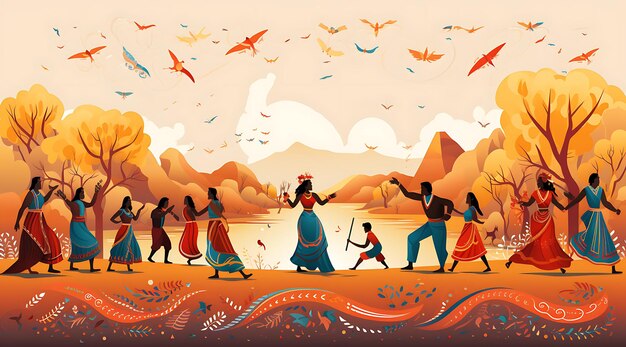The concept of banner art serves as a fascinating intersection between culture, identity, and the ever-evolving aesthetic sensibilities of societies around the globe. These vibrant visuals encapsulate the essence of human expression, weaving myriad narratives through a single frame. Cultural banners are not mere decorative elements; they act as conduits of historical significance and vehicles for communal storytelling. They reflect the complex interplay between tradition and modernity while illuminating our shared humanity.
One primary observation regarding banner concept art is its capacity to capture the richness of cultural events. Festivals, exhibitions, and other communal gatherings utilize banners to create an immediate visual impact that resonates with attendees. These banners often showcase traditional motifs, intricate designs, and symbolic imagery that draw upon the cultural heritage of specific communities. For instance, Indigenous cultural dance showcases prominently feature elements that honor ancestral customs and practices. The choreography, the clothing, and indeed the banners themselves converge to create an immersive experience, inviting spectators into a world brimming with meaning.
Exploring the aesthetic dimensions of cultural banners reveals deeper reasons for fascination. The vivid colors, bold patterns, and carefully chosen symbols do not exist in isolation; they encapsulate the spirit and values of the cultures they represent. For example, colors can evoke particular emotions and signify various attributes within different cultural contexts. In some traditions, white may symbolize purity, while in others, it may represent mourning. These multi-layered meanings imbue banner art with a depth that prompts viewers to contemplate their own emotional responses, creating a dialogue between the artwork and the observer.
Moreover, the design of banners often involves a meticulous blending of contemporary artistic practices with age-old techniques. Artists tasked with creating these visual narratives respect traditional forms while simultaneously experimenting with modern aesthetics. This fusion of styles reflects the dynamic nature of culture; it acknowledges that while certain elements of tradition endure, others evolve. Such transformations are evident in the use of digital technology to design banners that still convey traditional messages, demonstrating how cultural identity can adapt without losing its core essence.
Delving into the socio-political context of cultural banners opens another dimension of understanding. In many instances, these artworks serve as instruments of advocacy, amplifying voices that may otherwise remain unheard. For marginalized communities, banners can be powerful tools for resistance and empowerment. They can promote awareness about social issues and historical injustices, acting as visual manifestos. Thus, a banner representing a cultural dance is not merely a celebration but also a reclaiming of narrative in a world that often sidelines minority perspectives.
This aspect underlines the significant role of visual symbolism in cultural banners. The choice of images and symbols can convey messages of unity, resilience, and hope. For example, a banner adorned with a tree may symbolize life, growth, and continuity, often representing how cultures are deeply rooted in their environment. This relationship highlights a collective identity that is intrinsically linked to the land and its resources. It serves as a poignant reminder of the environmental challenges faced by many communities, thereby inviting discourse on sustainability and environmental stewardship.
It is worth considering how the proliferation of digital platforms has transformed the way cultural banners are displayed and disseminated. In an age dominated by social media, these pieces of art can reach international audiences, allowing for cross-cultural interactions that were previously unimaginable. This raises questions about cultural appropriation versus cultural appreciation—how one navigates the fine line between honoring a tradition and commodifying it? Such dialogues are critical as they shape the future trajectory of cultural expression in an increasingly globalized world.
Furthermore, the design of cultural banners often necessitates collaboration among community members. This cooperative approach fosters a sense of belonging and shared ownership over cultural narratives. Engaging various artists, historians, and cultural practitioners ensures that the resulting artwork accurately reflects the community’s values and experiences. Such collaborative efforts underscore the democratic nature of art; they invite collective participation in the creative process, reinforcing cultural bonds and preserving heritage through generations.
On a philosophical level, the enduring appeal of cultural banners invites contemplation about identity itself. In a rapidly changing world where globalization often blurs the lines between cultures, these artworks serve as bastions of identity. They remind us of who we are and where we come from, while also challenging us to reflect on the interplay between local and global influences. The visual language of cultural banners compels us to confront the complexities of our existence and the myriad ways in which we express belonging.
In conclusion, banner concept art emerges as a profound cultural artifact that transcends mere aesthetics. Rich in tradition, replete with symbolism, and constantly evolving, these creations signify a broader narrative about human connections. They capture personal and collective histories, advocating for representation and preserving legacies. The multi-dimensional nature of cultural banners reminds us that while they adorn our physical spaces, they also occupy a significant place in our social consciousness, beckoning us to explore the intricacies of culture in a world marked by change.
